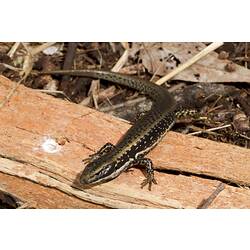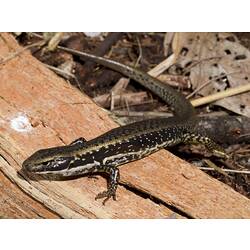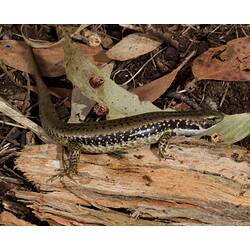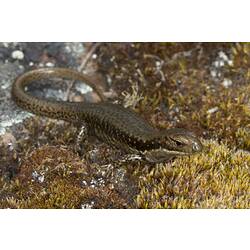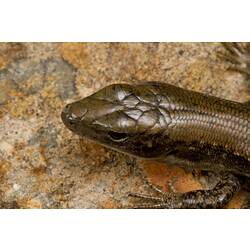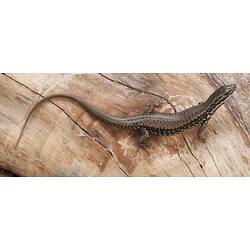General Description
Medium sized lizard with golden to brown-black back with scattered black scales on the upper side. The back edge of the ear opening is pale. Broad black zone on flanks with whitish flecks. Lower side area paler with dark and light flecks. Belly pale metallic grey, sometimes with grey smudges. Hind limbs and toes long. Average snout to vent (the opening near the base of the tail) length is 7.5 cm.
Biology
An agile, diurnal (ie. active during the day) lizard most commonly found along waterways and small creeks where it can be seen basking on rocks, logs and vegetation. The Southern Water Skink bears live young with females giving birth to between 1 and 6 offspring in mid to late summer.
Distribution
Sothern and eastern Victoria and south-eastern New South wales
Habitat
Creeks and swamps in mountainous areas
More Information
-
Animal Type
-
Animal SubType
-
Brief Id
A medium-sized olive-brown skink with scattered black specks on the back and head. Often found basking on logs near waterways.
-
Colours
Black, Brown, Gold, White, Cream, Grey
-
Maximum Size
15 cm
-
Habitats
-
Diet
Invertebrates
-
Diet Categories
Insects, Invertebrates
-
Hazards
Harmless to humans but may bite if handled
-
Endemicity
-
Commercial
No
-
Conservation Statuses
CITES: Not listed, FFG Threatened List: Not listed, EPBC Act 1999: Not listed, IUCN Red List: Least Concern
-
Taxon Name
-
Scientific Author
(Lonnberg & Andersson, 1913)
-
Common Name
Southern Water-skink
-
Kingdom
-
Phylum
-
Subphylum
-
Class
-
Subclass
-
Order
-
Suborder
-
Infraorder
-
Family
-
Genus
-
Species Name
tympanum


